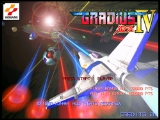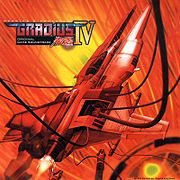
Gradius IV Fukkatsu
Encyclopedia
is the fourth arcade
installment in a series of scrolling shooter video games developed by Konami Computer Entertainment Tokyo. It was preceded by Gradius III
, released in 1989
, although other non-numbered spinoffs had been released such as Gradius Gaiden
. This title brings a considerable graphical upgrade, particularly with the use of colored lighting. In addition, there have been several additions and removals to the vaulted weapons system; specifically, the edit mode has been removed and an online ranking system was added.
. First of all, the edit mode has been completely eliminated, as are the "Snake Option" (s.option), the "Reduce" shield type, and the seventh powerup category. The seventh powerup category was the one that was labeled "!" and would produce detrimental results, such as reducing the speed or eliminating the weapons of the ship.
In this game there are a total of six configurations, the first four of which are migrated from Gradius II
. There two new configurations are as follows:
Configuration 5: The missile mode is a vertical mine that is released above and below the ship. After a short delay, the mines explode, yielding a large explosion. The double mode is the standard 45-degree angle split. The laser mode is a thin armor piercing round that can penetrate multiple enemies.
Configuration 6: The missile mode is the flying torpedo, which produces two missiles that fly forward in front of the ship. The double mode is the tailgun, seen in other configurations. The laser is the twin laser seen in Gradius III
.
Starting a tradition that is continued in Gradius V
, this game introduced an online-ranking system. After a player's game was over, a password was presented. This password, which was hashed scoring information, could be uploaded to a Konami website http://www.konami.co.jp/am/gra4/RANK/index.html. This ability was only available in Japan
, and was discontinued on August 27 of 1998
. This was similarly done for the Gradius III and IV console release. Score recording was disabled approximately a year after its arcade brethren.
in 2000 and as a part of Gradius Collection for the PlayStation Portable
in 2006. The former also includes a boss rush mode (play all the game's bosses in a time attack fashion) and a stage select.
 Gradius IV Fukkatsu Original Game Soundtrack was developed by Atsuki and released by Konami
Gradius IV Fukkatsu Original Game Soundtrack was developed by Atsuki and released by Konami
on March 5, 1999 in Japan.
General resources
Arcade game
An arcade game is a coin-operated entertainment machine, usually installed in public businesses such as restaurants, bars, and amusement arcades. Most arcade games are video games, pinball machines, electro-mechanical games, redemption games, and merchandisers...
installment in a series of scrolling shooter video games developed by Konami Computer Entertainment Tokyo. It was preceded by Gradius III
Gradius III
Gradius III, known in Japan as , is a side-scrolling shooting game originally released for the arcades in Japan and Asia in . It is the second sequel to the original Gradius for the arcades following Gradius II, and was followed by Gradius IV. Gradius III was rereleased for the Super Nintendo...
, released in 1989
1989 in video gaming
-Notable releases:* October 3, Brøderbund releases the Prince of Persia game, the first in a series of games, noted for its advancements in animation....
, although other non-numbered spinoffs had been released such as Gradius Gaiden
Gradius Gaiden
is horizontal scrolling shooter video game produced by Konami and released in Japan on August 28, 1997. It is the first Gradius-named title to incorporate 3D graphics.-Gameplay:...
. This title brings a considerable graphical upgrade, particularly with the use of colored lighting. In addition, there have been several additions and removals to the vaulted weapons system; specifically, the edit mode has been removed and an online ranking system was added.
Gameplay
The core gameplay of Gradius IV remains relatively unchanged. However, several changes were made on the weapons system in the transition from Gradius IIIGradius III
Gradius III, known in Japan as , is a side-scrolling shooting game originally released for the arcades in Japan and Asia in . It is the second sequel to the original Gradius for the arcades following Gradius II, and was followed by Gradius IV. Gradius III was rereleased for the Super Nintendo...
. First of all, the edit mode has been completely eliminated, as are the "Snake Option" (s.option), the "Reduce" shield type, and the seventh powerup category. The seventh powerup category was the one that was labeled "!" and would produce detrimental results, such as reducing the speed or eliminating the weapons of the ship.
In this game there are a total of six configurations, the first four of which are migrated from Gradius II
Gradius II
is a horizontally-scrolling shooter originally released for the arcades in Japan in . It is the sequel to original Gradius and was succeeded by Gradius III. Ports of Gradius II were released for the Family Computer, PC-Engine Super CD-ROM², and X68000 in Japan...
. There two new configurations are as follows:
Configuration 5: The missile mode is a vertical mine that is released above and below the ship. After a short delay, the mines explode, yielding a large explosion. The double mode is the standard 45-degree angle split. The laser mode is a thin armor piercing round that can penetrate multiple enemies.
Configuration 6: The missile mode is the flying torpedo, which produces two missiles that fly forward in front of the ship. The double mode is the tailgun, seen in other configurations. The laser is the twin laser seen in Gradius III
Gradius III
Gradius III, known in Japan as , is a side-scrolling shooting game originally released for the arcades in Japan and Asia in . It is the second sequel to the original Gradius for the arcades following Gradius II, and was followed by Gradius IV. Gradius III was rereleased for the Super Nintendo...
.
Starting a tradition that is continued in Gradius V
Gradius V
Gradius V is a Japanese-developed shoot 'em up video game published by Konami for the Sony PlayStation 2 video game console in 2004. Gradius V was largely developed under contract by the Treasure team responsible for Radiant Silvergun and Ikaruga under supervision of Konami's internal development...
, this game introduced an online-ranking system. After a player's game was over, a password was presented. This password, which was hashed scoring information, could be uploaded to a Konami website http://www.konami.co.jp/am/gra4/RANK/index.html. This ability was only available in Japan
Japan
Japan is an island nation in East Asia. Located in the Pacific Ocean, it lies to the east of the Sea of Japan, China, North Korea, South Korea and Russia, stretching from the Sea of Okhotsk in the north to the East China Sea and Taiwan in the south...
, and was discontinued on August 27 of 1998
1998 in video gaming
-Events:*Academy of Interactive Arts & Sciences hosts 1st Annual Interactive Achievement Awards; inducts Shigeru Miyamoto of Nintendo to the AIAS Hall of Fame*British Academy of Film and Television Arts hosts the 1st annual BAFTA Interactive Entertainment Awards...
. This was similarly done for the Gradius III and IV console release. Score recording was disabled approximately a year after its arcade brethren.
Ports
Gradius IV Fukkatsu never received a direct port. It was included in the Gradius III and IV compilation for the PlayStation 2PlayStation 2
The PlayStation 2 is a sixth-generation video game console manufactured by Sony as part of the PlayStation series. Its development was announced in March 1999 and it was first released on March 4, 2000, in Japan...
in 2000 and as a part of Gradius Collection for the PlayStation Portable
PlayStation Portable
The is a handheld game console manufactured and marketed by Sony Corporation Development of the console was announced during E3 2003, and it was unveiled on , 2004, at a Sony press conference before E3 2004...
in 2006. The former also includes a boss rush mode (play all the game's bosses in a time attack fashion) and a stage select.
Audio

Konami
is a Japanese leading developer and publisher of numerous popular and strong-selling toys, trading cards, anime, tokusatsu, slot machines, arcade cabinets and video games...
on March 5, 1999 in Japan.
External links
OfficialGeneral resources

